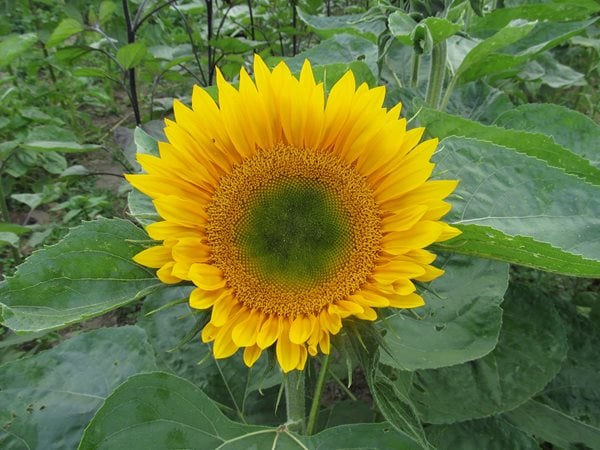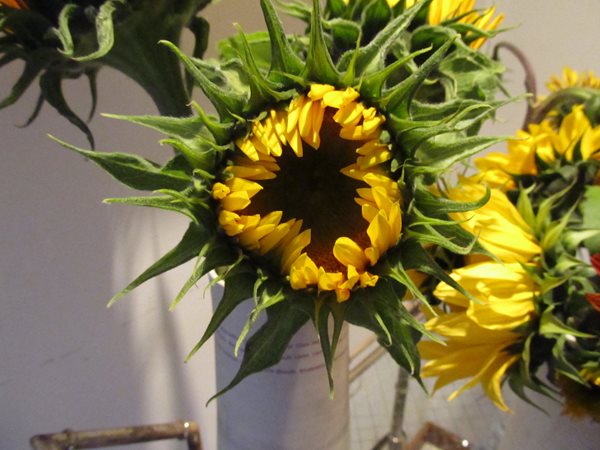Sunflowers, Zinnias, and Dahlias
Now that Labor Day is behind us and the kids are heading back to school, Katherine Anderson of Marigold and Mint creates a few late summer flower arrangements with three favorite flowers of the season: sunflowers, zinnias, and dahlias.

Late summer and early fall are the perfect time for three many petaled flowers: dahlias, zinnias, and sunflowers. All three are part of the same family, Asteraceae, which also includes chrysanthemums, marigolds, and dandelions. I grow all three on my farm and I thought that they would be perfect to put together in an arrangement for September, in these last days of summer. Depending on where you live, these flowers should be available through early fall, whether they're harvested from your garden or purchased at the farmer's market.
Marigold and Mint is an organic farm, a retail shop, and a studio. The farm is situated along the Snoqualmie River, about 30 miles east of Seattle and the shop is located in the Melrose Market on Capitol Hill in Seattle, Washington. Founded in 2008 by owner Katherine Anderson, Marigold and Mint reflects her lifetime love of flowers and landscapes. Trained as a landscape architect, she brings her affection for both clean and clear design and intricate patterns to Marigold and Mint.

About this time of the season, I wonder if flower farming is worth all the effort. In the end it costs so much to grow one flower, some of which will never sell.
But then comes August and early September and seeing the sunflowers in my field makes me feel like I’ve done something heroic, paving the way for a seed to grow into something so sturdy and strong and that the bees absolutely love. I like to take that strength and allow my arrangements to become something less straightforward and more mysterious, just like the path of a seed to six-foot flower.

Izzie Klingels, an artist who works in my shop, says my pro cut sunflowers (the name of certain varieties of sunflowers) look like flowers on Prozac. She’s right: They are perky and bright and kind of boring. Even so, they have some good qualities in the field and in the vase, including uniformity, durability, and mesmerizing pattens in their green centers.

But I’m with Izzie, and prefer my more eccentric suns, including the spiky brown ones and the plush teddy bear-types. One of the ways I like to arrange these more unusual varieties is in a grouping of vases of varying heights, allowing them to nod towards each other, and even hang their heads a bit.

And if you harvest your sunflowers before they really open, they feel modern, and prickly like an artichoke (to which they are related).
Similarly, if the petals on your sunflowers are starting to fall off, try a florist’s trick and remove all of the petals, leaving you with a disk ringed with a geometric green collar.

A number of the sunflower’s companions in the late summer flower field are often sold in their most straightforward manifestations, such as crayon colored zinnias and primary red dahlias. Zinnias and dahlias sometime have a bit of a reputation as "grandma flowers," but I wonder if their boldness allows them in some way to stand up to intense summer heat. In any case, as with sunflowers, I prefer to bypass the obvious types, choosing pastels or whites, for example, and then combining them with berries and seed pods.
Let’s start with white zinnias and mix them with white dahlias in a contemporary black and white Scandinavian vase. To these blooms, I’ve added white nigella in various stage of development, from the flower before it opens to the fully articulated seed pod.

The vase makes it feel modern, as does the white-on-white (with a splash of black) flower scheme. In this way, the arrangement plays against the reputation of dahlias and zinnias as fussy flowers.

In the same spirit as the white arrangement, I pulled together dahlias and zinnias in tones ranging from apricot to soft orange. This also happens to be when my viburnum berries are the prettiest, and so I grabbed those, too.

I begin with the dahlia, carefully standing about four or five stems up in the vase. Be sure to remove the bottom leaves—you can keep or remove the extra buds on the dahlia depending on how tight you want the arrangement to look. I tend to leave them, unless it’s an arrangement in the shop where I know the customer would prefer it otherwise.

As you fill in the arrangement with the zinnias, they will hold the dahlias in place. I try to vary the ways the zinnias rest next to the dahlias—some, I place just under the dahlias and others, next to and slightly above the blooms—so the arrangement doesn’t end up looking like a tight floral soccer ball (not that those aren’t fun sometimes, but again, like the pro cut suns, a little static and boring).
You have to think about how the faces of the flowers are talking to each other—and I prefer them talking, as opposed to all staring wide-eyed out into space. Finally, add the viburnum.

If this feels too precious, try adding another color of one of the flowers, such as the bicolor Queen Red Lime zinnia (my absolute favorite variety right now).

The acid green of the Queen Red Lime zinnia wakes up the apricot hues of the other flowers, like a welcome drenching from a cold hose on a hot day.

Of course the face of a dahlia can be perfect and trance-inducing all by itself. I could gaze at a single dinner-plate pale pink dahlia all day.

It looks perfect to me, displayed on its own in a mercury glass vase.

A pink dahlia's sweetness can also be juxtaposed with the soft green of a succulent and the aforementioned Queen Red Lime variety. Depending on how you choose to showcase these flowers, dahlias, zinnias, and sunflowers can look fresh and modern and are a colorful way to decorate the table in these last few weeks of summer.




